Local radio stations in Spain are turning into radio group affiliates. Is filling local content windows inside nationally syndicated formats all that will be left of local radio?
I sincerely hope not. But Global Radio has already become the Clear Channel of the UK, and remote-controlled network programming seems to grow in more countries. Like in Spain, where more and more content is nationally produced and locally syndicated. The good news? Radio will always be a part of people’s lives. Hopefully also local radio.
Local radio station visits
An interesting thing happens when I’m on holidays. I always end up in the studio of a local radio station there! I guess radio is a virus that you always carry with you. Speaking with radio professionals in other markets always gives me a fresh perspective and new inspiration. This Summer, I stumbled upon local studios of two national radio networks in Spain during my visit of the historic city of Elche. I walked in and found an English-speaking staff member who gave me a guided tour through their recently renovated studios. Among other things, we spoke about radio’s current economic challenges, and how they produce quality output with minimum costs through technical solutions.
 Los 40 & Cadena SER
Los 40 & Cadena SER
Instead of having their own brands, local broadcaster Radio Elche is an associate of two nationwide channels. Los 40 Principales (pronounced los cuarenta principales, which stands for: the Top 40) is Spain’s number 1 hit music station. Cadena SER is Spain’s overall most popular radio station and has a News-Talk format. As a local affiliate of these networks, Radio Elche is transmitting a localized version of the two national programs.
Spanish radio license regulations
PRISA in Madrid owns and operates the Los 40 Principales and Cadena SER brands, but doesn’t have FM frequencies in every part of Spain. As the country is divided into 17 autonomous communities which all have their own governmental structure, Spanish media companies have to apply for a broadcast license in every department of the country separately. It’s a diplomatic game. I’ve been told that when a station’s political tendency is close to the local government in power, it’s more likely to get a license.
“It’s incredible, it’s difficult, but it’s thrilling”
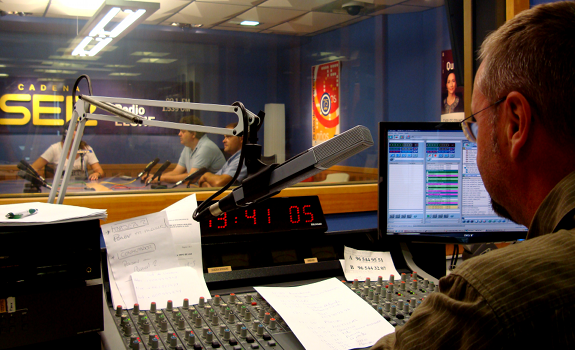
Former radio presenter and journalist José Manuel Richart now works in the commercial department of Cadena SER where he also serves as a board-op for talk hosts when the regular technician is on holiday (photo: Thomas Giger)
Nationwide syndicated radio programming
National operators that don’t win this beauty contest, often partner with local enterprises that already own a license in a certain community. They often enter a (kind of) franchise construction where the local affiliates simulcast the nationwide programming, which carries optional windows for local content. This is basically what they do in Elche. The two stations of Radio Elche use the national brands, formats and programming of Los 40 Principales and Cadena SER, but they’re not owned by them.
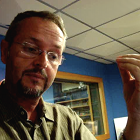 Multitasking local radio staff
Multitasking local radio staff
At the stations I’ve been given a tour by José Manuel Richart (photo) who is Spanish, but has a French father and studied English philology. His daily work is just as diverse as the languages he speaks. “I’m supposed to be a journalist, but in small radio stations, everybody has to do everything.” He has been a deejay, presenter, editor, and now works in the commercial department. “We cannot have one person for one task. We are versatile.”
Local radio production efficiency
How do you experience this work life of being a flexible multitasker?
“It’s incredible, it’s difficult, but it’s thrilling because you have an overall view of radio. You’re not fixed on one task only and you don’t get bored. When you spend many weeks, many months, many years doing the same thing, your work becomes sort of a routine.” Richart foresees that working flexibility is the future of local radio: “You have to do as many things as you can. That’s also what employers like to have.”
“People who are listening don’t notice the difference”
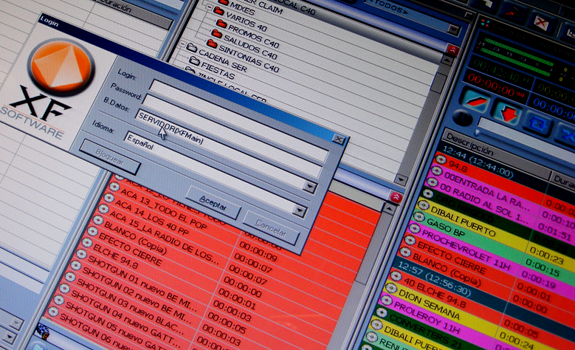
The radio automation of Los 40 Principales in Elche can be controlled remotely via satellite from the headquarters in Madrid, where all the nationwide broadcasted network programming is being produced (photo: Thomas Giger)
National network brand stylebook
Even if their local editions of Los 40 Principales and Cadena SER are not owned by its brand licensor in Madrid, they’re not allowed to do everything they want inside the local windows. “We must follow national network directions”, José Manuel Richart explains. They have a stylebook that defines brand guidelines and format rules. Instructions on how to handle music on the air include the universal radio law that your ramp talk should end after the artist is starting to sing at the end of a song intro. “The target is that whether Madrid or Elche are broadcasting, people who are listening don’t notice the difference.”
 Local content & commercial breaks
Local content & commercial breaks
What’s the value of local editions for music formats like Los 40?
“Sometimes we have local concerts or events, and something as simple as saying: ‘hello, we’re in Elche, and it’s 23 degrees’ lets people feel closer to the station”, Richart knows. Local windows are also being used for non-spot advertising, like a sponsored local weather forecast. But besides 2-3 daily local hours, program content is delivered from Madrid via satellite.
Centralized promo & imaging production
Apart from these few complete local hours, the station has many small local windows. Every hour at 43’00” they have a window of 3.5 minutes during which local commercials are scheduled. In case they don’t sell out the entire break, they use station promotion spots and imaging elements to fill up stopsets and stay in sync with the network programming. Most production elements are being produced in Madrid as well, and distributed to affiliate stations via download links on the group’s intranet.
“Things have changed very much”
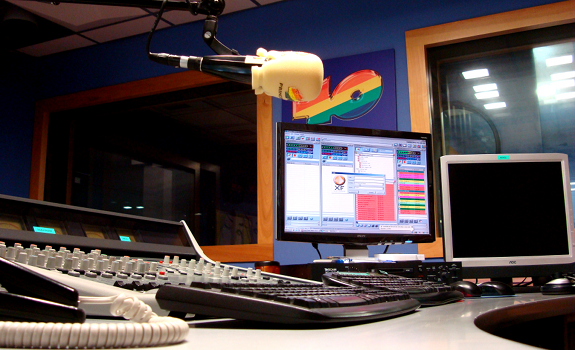
This on-air studio of Los 40 Principales in Elche is only used for a couple of hours a day now, as the entire station is based on a live, satellite-delivered network programming feed that is produced in Madrid (photo: Thomas Giger)
Radio industry job cuts
Being part of a well-established brand helps local sales. “It’s easier to sell advertising for Los 40 Principales than for a very little station”, José Manuel Richart experiences. The other benefit is cost control. Program syndication means less investment and more return, but increased profit has a price – people’s jobs. Not long ago, Radio Elche had 20 people working on local shows from 8 AM to 9 PM. Today, 4 of them are left: 1 for Los 40 Principales and 3 for Cadena SER. “Things have changed very much. It’s getting more advanced in technical terms, but it’s getting lower and lower in terms of human resources.” He mentions that national groups are affected, too. Cadena SER fired 800 employees already and will probably cut 200 more jobs.
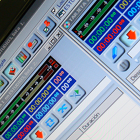 Local presence less significant
Local presence less significant
What effect has automation on the personal station-listener relation?
When discussing this in program meetings, Richart often hears the argument: “When they tune in, listeners want to hear something interesting or music they like. They’re not concerned whether the person that talks is in Elche or in Madrid.” He adds that local shows never made a difference for them in terms of the ratings. “The costs are not compensated through commercial benefits.”
Pirate radio advertising competition
Are there still independent stations that don’t attach themselves to a national brand?
José Manuel Richart smiles: “There are many little independent radios spread all over Spain, but there are twice as much pirate stations than legal ones.” In his opinion, price dumping pirates are destroying the entire local radio advertising market. “You go to a client and say: we have 100,000 listeners on Los 40 Principales here in Elche. It’s the number 1 station and you have to pay 20 Euros for 1 spot of 30 seconds. An illegal station sells the same commercial for 1 Euro.” He says that even the legal stations battle for the advertiser’s money, in a country where radio ads have decreased “40%” between 2006 and 2012.
“Music radio will always exist”
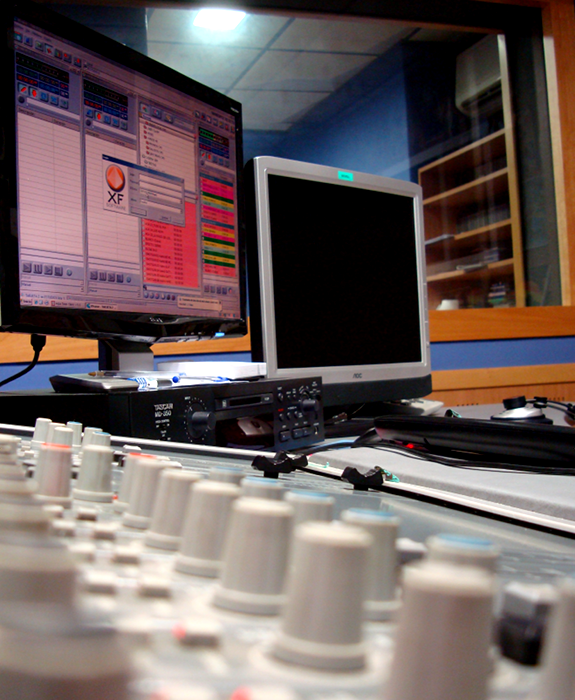
José Manuel Richart sees radio as main launch platform for new music, also in the future (photo: Thomas Giger)
From jock to journalist
Richart started his career at music station Los 40 Principales and later moved to talk-based Cadena SER. “People in front of the microphone must have something in common with listeners. If you’re 50 years old like me, perhaps you’re not in the same onda; not in the same wave as young people.” He advises to keep your radio job challenging by developing yourself. “Once you’ve done many years of music shows, you have reached a ceiling. In Cadena SER you have more possibilities, as you can work like a true journalist. To me, that is much more interesting than to spend two hours before a microphone to introduce all the songs.”
 Radio’s music guide function
Radio’s music guide function
Looking at how young people use radio, what’s music radio’s future?
“The kind of radio that we have in the near or middle future will perhaps not be like the one we’re used to. But I believe that music radio will always exist, as the easiest way to find new music is to turn on the radio. Once you have listened to it and like it, then you go to iTunes or Spotify and download it, but the first contact with music will be through music radio.”
Mobile phone broadcast platform
Also for young people? They don’t go straight to YouTube to find the new Calvin Harris?
“I don’t know what will happen in 3 years, but here in Spain we still don’t have the possibility to listen to [webradio] on mobile phones. You need special data plan that not everyone can afford”, José Manuel Richart explains. He sees that many young and middle-aged people often listen to radio on their mobile phone through its FM application. “When I’m home, working on the computer, I listen online instead of using my traditional radio receiver. I have am application called TapinRadio, where you can find stations from all over the world. But when I’m on the beach or when I’m jogging, I use the FM application of my phone.”
“You have someone who is talking to you”
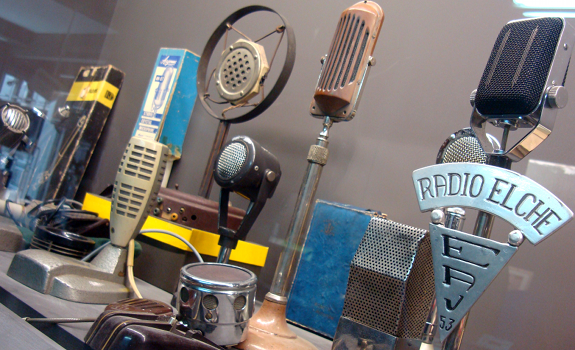
The emotional bond between listeners and their favorite radio station is strong since the very first years of radio broadcast history, and it probably remains to be radio’s USP for several years to come (photo: Thomas Giger)
Radio’s speed & social bonding
What are radio’s main benefits from a listener’s perspective that radio people should use?
“When something happens, listeners can know it at once. It is true that we have social networks, like Twitter and Facebook, but radio is very, very fast. Every morning after I get up, I take a shower while listening to the radio. I can’t be with my mobile, but I like very much to know what’s happening. And also if you are alone, you have someone who is talking to you and who is by your side. I think that this is very important – and that it will continue to be so. In the near future, at least.”
Read also:
- Future (related articles)
Stay tuned, follow us @RadioILOVEIT and click below to share this post:





Hi Marc,
Nice to hear from you!
The radio automation in the pictures is called XFrame, made by XF Software in Madrid.
It’s the first time I’ve seen this system, and based on the references on the developer’s website, it’s mainly used by Spanish radio stations.
Maybe it’s an interesting test case for the radio automation section of your nice blog?
Cheers,
Thomas
Which radio automation is used on the pictures?